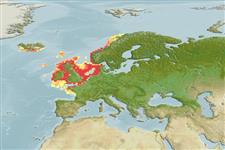Environment: milieu / Zona climática / intervalo de profundidade / distribution range
Ecologia
marinhas; estuarina demersal; oceano-estuarine (Ref. 57987); intervalo de profundidade 10 - 90 m (Ref. 1371), usually 10 - 50 m (Ref. 35388). Temperate; 70°N - 44°N, 24°W - 22°E
Northeast Atlantic: around the British Isles and northward along the European coasts to northern Norway. Also found at the Faeroe Islands and Iceland.
Comprimento de primeira maturação / Tamanho / Peso / Idade
Maturidade: Lm 6.2 range ? - ? cm
Max length : 20.0 cm TL macho/indeterminado; (Ref. 1371)
Raios dorsais (total) : 48 - 51; Espinhos anais: 0; Raios anais : 41 - 43. Head relatively large, less than five times in SL. Skin fold above the upper lip with three pairs of lobes or small barbels. First fin ray followed by a row of small, fleshy filaments (Ref. 1371). One barbel on the lower jaw and four on the snout (Ref. 35388).
Body shape (shape guide): elongated; Cross section: oval.
Found in the sublittoral zone, on sand or mud bottoms. Feed mostly on decapod crustaceans, lobsters, crabs, mysids and polychaetes (Ref. 3663). Oviparous (Ref. 205). Spawning may take place in deeper waters (Ref. 57987).
Probably pairs up during breeding (Ref. 205).
Cohen, D.M., T. Inada, T. Iwamoto and N. Scialabba, 1990. FAO species catalogue. Vol. 10. Gadiform fishes of the world (Order Gadiformes). An annotated and illustrated catalogue of cods, hakes, grenadiers and other gadiform fishes known to date. FAO Fish. Synop. 125(10). Rome: FAO. 442 p. (Ref. 1371)
Status na Lista Vermelha da UICN (Ref. 130435: Version 2025-1)
Ameaça para os humanos
Harmless
Uso pelos humanos
Pescarias: espécies comerciais
Ferramentas
Relatórios especiais
Baixar XML
Fontes da internet
Estimates based on models
Preferred temperature (Ref.
123201): 7.7 - 12.3, mean 10.3 °C (based on 564 cells).
Índice de diversidade filogenética (Ref.
82804): PD
50 = 0.6250 [Uniqueness, from 0.5 = low to 2.0 = high].
Bayesian length-weight: a=0.00724 (0.00420 - 0.01251), b=3.15 (3.00 - 3.30), in cm total length, based on LWR estimates for this species & (Sub)family-body (Ref.
93245).
Nível Trófico (Ref.
69278): 3.5 ±0.44 se; based on food items.
Generation time: 1.3 ( na - na) years. Estimated as median ln(3)/K based on 1
growth studies.
Resiliência (Ref.
120179): Elevada, tempo mínimo de duplicação da população menor que 15 meses (tm=1; tmax=3).
Fishing Vulnerability (Ref.
59153): Low vulnerability (16 of 100).
🛈
Nutrients (Ref.
124155): Calcium = 79 [39, 186] mg/100g; Iron = 0.47 [0.24, 0.96] mg/100g; Protein = 17.6 [15.7, 19.4] %; Omega3 = 0.445 [0.215, 0.871] g/100g; Selenium = 12.5 [5.8, 34.8] μg/100g; VitaminA = 12.8 [3.4, 46.0] μg/100g; Zinc = 0.834 [0.570, 1.278] mg/100g (wet weight);
